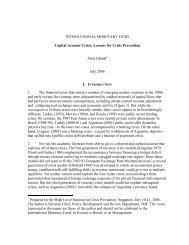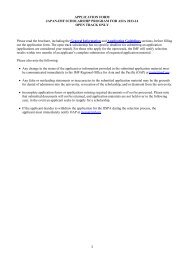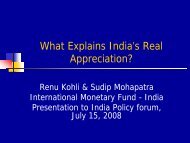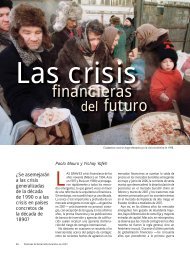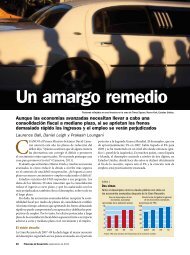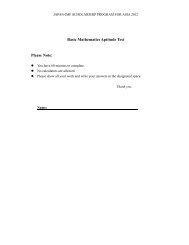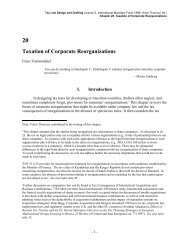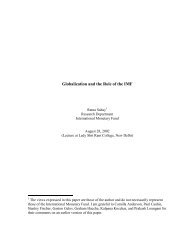Competition Policy and Monetary Policy - Per Jacobsson Foundation
Competition Policy and Monetary Policy - Per Jacobsson Foundation
Competition Policy and Monetary Policy - Per Jacobsson Foundation
You also want an ePaper? Increase the reach of your titles
YUMPU automatically turns print PDFs into web optimized ePapers that Google loves.
Mario Monti 11<br />
in 1999. This unitary feature of policymaking is a key prerequisite,<br />
among others, for the EU to be respected as an interlocutor<br />
in international coordination.<br />
The third similarity between monetary policy <strong>and</strong> competition<br />
policy, at least in Europe, is organizational. What I believe we<br />
have seen in Europe is that monetary policy was born national,<br />
<strong>and</strong> then when it was realized that monetary sovereignty nationally<br />
consisted only in having a few minutes available each<br />
Thursday afternoon to change one’s own interest rate after the<br />
spokesperson of the German Bundesbank had said what it had<br />
decided, then gradually, but not too gradually, it was decided<br />
to have a unitary monetary policy in the European Central Bank<br />
(ECB).<br />
For competition policies, the process has been the opposite.<br />
With the exception of Germany, no other member state of the<br />
then-six members of the European Economic Community had in<br />
1957 a national competition policy, so competition policy was<br />
created European.<br />
But just as, recently, the European System of Central Banks<br />
<strong>and</strong> the ECB have emerged from national central banks—bottomup,<br />
one could say—in parallel <strong>and</strong> apparently in contradiction, a<br />
deep reform of the architecture of competition policy has been<br />
put in place since May 2004 in the EU, <strong>and</strong> that is a top-down approach.<br />
Now for many aspects of community competition policy,<br />
the enforcer is no longer Brussels alone, but a European <strong>Competition</strong><br />
Network with 26 competition authorities—the Commission<br />
<strong>and</strong> the National <strong>Competition</strong> Authorities.<br />
The fourth similarity is a crucial one, independence, <strong>and</strong> in<br />
different ways it would be interesting to deepen this subject. In<br />
Europe, there is independence both for monetary policy <strong>and</strong> for<br />
competition policy, even though this is not always the case for<br />
that part of competition policy that is done nationally, not as a<br />
result of the devolution that I just mentioned, but as a result of<br />
the original national competition laws introduced in the 1970s,<br />
1980s, <strong>and</strong> 1990s. For example, to be very concrete, there is now<br />
a big case going on between Germany <strong>and</strong> Spain in the energy<br />
sector—you might have heard of this—with E.ON trying to acquire<br />
Endesa. Now the Spanish government favors the formation<br />
of a national champion by authorizing the merger between<br />
Gas Natural <strong>and</strong> Endesa. That merger was not authorized by the





